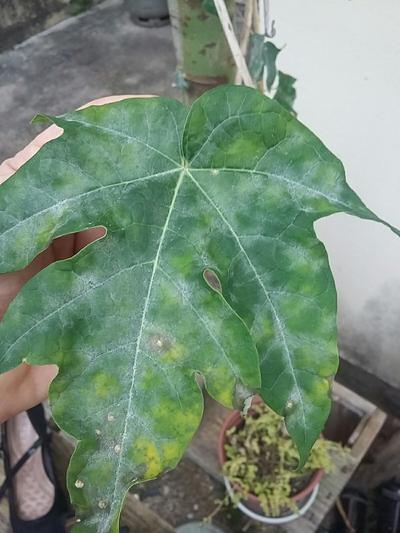Powdery Mildew of Papaya
Oidium caricae-papayae
Fungus
In a Nutshell
- Speckled water soaked spots on leaf underside.
- Later become powdery patches.
- Spots enlarge, covering leaf.
- Chlorotic and distorted leaves.
- Premature leaf fall.
Can also be found in
Symptoms
Water-soaked spots covered with whitish powdery fungal mats appear first on the underside of leaves, often adjacent to the leaf veins, on leaf petioles and and at the base of flowers. Occasionally, pale green to yellow spots arise on the upper side of the leaves, sometimes covered with white mold. These spots may turn necrotic brown and be surrounded by a yellow halo later. Heavily infected leaves later whither and curl inwards. The fruits might show mats of whitish mold of variable sizes. The infection generally causes little damage to old bearing trees. However, in young plants it can lead to the death of growing tissues, defoliation, stem and fruit lesions and important yield losses.
Recommendations

Organic Control
Wettable sulfur, sulfur dust, or lime sulfur as well as potassium bicarbonate have proved helpful in controlling this disease. However, these treatments can be toxic to the plants if applied during hot weather. In some cases, baking powder, neem oil extracts and soap solutions can be useful. In all cases, these treatments are not very effective if the disease is severe.

Chemical Control
Always consider an integrated approach with preventive measures together with biological treatments if available. Fungicides such as azoxystrobin, mancozeb can be applied to control powdery mildew on papaya.
What caused it?
The disease is caused by the fungus Oidium caricae-papayae. The fungus survives and reproduces on papaya plants only. The spores are dispersed from plant to plant and between fields by wind. Leaves at all growth stages can be affected, but older leaves are more susceptible. The fungus colonizes the epidermal plant cells, which is what causes the symptoms. The development of the disease and the severity of the symptoms are promoted by low light levels, a high degree of humidity, moderate temperatures (18 to 32°C), and rainfall ranging from 1500 to 2500 mm per year.
Preventive Measures
- Plant more resilient varieties.
- Plant trees in well-ventilated areas with sufficient space between rows.
- Avoid areas with high humidity and temperatures below 24°C.
- Do not irrigate with overhead sprinklers.
- Water the plants early in the day.
- Water at the root zone.
- Ensure balanced nutrition and avoid high nitrogen fertilization.
- Remove infected plant parts and destroy any plant residues.



